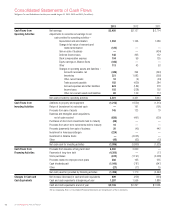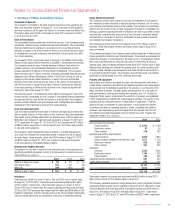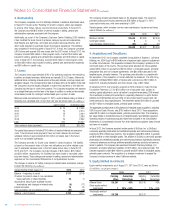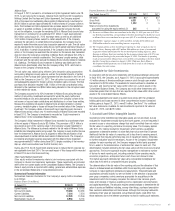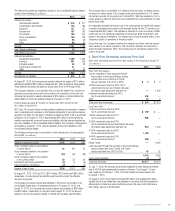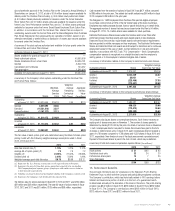Walgreens 2013 Annual Report Download - page 44
Download and view the complete annual report
Please find page 44 of the 2013 Walgreens annual report below. You can navigate through the pages in the report by either clicking on the pages listed below, or by using the keyword search tool below to find specific information within the annual report.
Notes to Consolidated Financial Statements (continued)
42 2013 Walgreens Annual Report
these pending matters, after consideration of applicable reserves and rights to indemni-
fication, will have a material adverse effect on the Company’s consolidated financial
position. However, substantial unanticipated verdicts, fines and rulings do sometimes
occur. As a result, the Company could from time to time incur judgments, enter into
settlements or revise expectations regarding the outcome of certain matters, and such
developments could have a material adverse effect on its results of operations in the
period in which the amounts are accrued and/or its cash flows in the period in which
the amounts are paid.
On a quarterly basis, the Company assesses its liabilities and contingencies for out-
standing legal proceedings and reserves are established on a case-by-case basis for
those legal claims for which management concludes that it is probable that a loss will
be incurred and that the amount of such loss can be reasonably estimated. Substantially
all of these contingencies are subject to significant uncertainties and, therefore,
determining the likelihood of a loss and/or the measurement of any loss can be
complex. With respect to litigation and other legal proceedings where the Company
has determined that a loss is reasonably possible, the Company is unable to estimate
the amount or range of reasonably possible loss in excess of amounts reserved due to
the inherent difficulty of predicting the outcome of and uncertainties regarding such
litigation and legal proceedings. The Company’s assessments are based on estimates
and assumptions that have been deemed reasonable by management, but that may
prove to be incomplete or inaccurate, and unanticipated events and circumstances may
occur that might cause the Company to change those estimates and assumptions.
Therefore, it is possible that an unfavorable resolution of one or more pending litigation or
other contingencies could have a material adverse effect on the Company’s consolidated
financial statements in a future fiscal period. Management’s assessment of current
litigation and other legal proceedings, including the corresponding accruals, could change
because of the discovery of facts with respect to legal actions or other proceedings
pending against the Company which are not presently known. Adverse rulings or
determinations by judges, juries, governmental authorities or other parties could also
result in changes to management’s assessment of current liabilities and contingencies.
Accordingly, the ultimate costs of resolving these claims may be substantially higher
or lower than the amounts reserved.
On April 4, 2012, the United States Drug Enforcement Administration (DEA) served
administrative inspection warrants on six Walgreen retail pharmacies in Florida and
removed certain controlled substance prescription records and other related documents.
DEA also served an inspection warrant and an administrative subpoena for records on the
Walgreens distribution center in Jupiter, Florida. DEA issued a separate administrative
subpoena for records from the Walgreens facility in Orlando, Florida, on August 8,
2012. On September 14, 2012, DEA served an Order to Show Cause and Immediate
Suspension Order (ISO) on the Jupiter distribution center and placed under seal the
controlled substance inventory at that facility. Walgreens timely requested a hearing
to demonstrate why DEA should not permanently revoke the controlled substance
registration from the Jupiter distribution center. On October 10, 2012, Walgreens
filed a petition in the U.S. Court of Appeals for the District of Columbia challenging
DEA’s authority to issue the ISO.
On June 11, 2013, the Company entered into a Settlement and Memorandum of
Agreement with the United States Department of Justice and the DEA that settles and
resolves all administrative and civil matters arising out of DEA’s concerns relating to the
Company’s distribution and dispensing of controlled substances. Under the terms of the
agreement, the Company paid an $80 million settlement amount, surrendered its DEA
registrations for the six pharmacies in Florida until May 26, 2014, and for its Jupiter
distribution center until Sept. 13, 2014, and agreed to implement certain remedial
actions. In addition, the Company dismissed with prejudice its petition with the United
States Court of Appeals for the District of Columbia Circuit.
On July 31, 2013 and August 13, 2013, putative shareholders filed derivative actions
in federal court in the Northern District of Illinois against the Walgreens Board of
Directors arising out of the Company’s recent settlement with the United States Drug
Enforcement Administration described above. The actions assert claims for breach of
fiduciary duty on the grounds that the directors allegedly should have prevented the
events that led to the settlement. The plaintiffs filed an amended consolidated
complaint on October 4, 2013, pursuant to which they seek damages and other
relief on behalf of the Company. In accordance with the schedule set by the court,
the defendants’ motion to dismiss is due on December 3, 2013.
SEC regulations require disclosure of certain environmental matters when a govern-
mental authority is a party to the proceedings and the proceedings involve potential
monetary sanctions that management reasonably believes could exceed $100,000.
On July 2, 2012, a number of California District Attorneys served the Company with
a civil complaint filed in the Alameda County Superior Court alleging certain violations
of the state’s hazardous waste regulations related to the proper disposal of various
materials from the Company’s retail stores and seeking injunctive relief, civil penalties
and certain fees and expenses. The California District Attorneys filed an amended
complaint on July 12, 2012, and a motion for preliminary injunction on August 6,
2012. On December 13, 2012, the Alameda County Superior Court approved a
settlement between the Company and the State of California. The settlement requires
the Company to pay penalties and costs and fund supplemental environmental projects
in the total amount of approximately $17 million, which was paid during fiscal 2013
and includes certain injunctive relief.
13. Capital Stock
The Company’s long-term capital policy is to maintain a strong balance sheet and
financial flexibility; reinvest in its core strategies; invest in strategic opportunities that
reinforce its core strategies and meet return requirements; and return surplus cash
flow to shareholders in the form of dividends and share repurchases over the long term.
In connection with the Company’s capital policy, the Board of Directors authorized a
share repurchase program (2009 repurchase program) and set a long-term dividend
payout ratio target between 30 and 35 percent of net income. The 2009 repurchase
program, which was completed in September 2010, allowed for the repurchase
of up to $2.0 billion of the Company’s common stock. On October 13, 2010,
the Board of Directors authorized the 2011 repurchase program, which was
completed in July 2011, which allowed for the repurchase of up to $1.0 billion
of the Company’s common stock. On July 13, 2011, the Board of Directors authorized
the 2012 repurchase program, which allows for the repurchase of up to $2.0 billion
of the Company’s common stock prior to its expiration on December 31, 2015.
Activity related to these programs was as follows (In millions) :
Fiscal Year Ended 2013 2012 2011
2009 stock repurchase program $ — $ — $ 360
2011 stock repurchase program — — 1,000
2012 stock repurchase program — 1,151 424
$ — $ 1,151 $ 1,784
The Company determines the timing and amount of repurchases from time to time
based on its assessment of various factors including prevailing market conditions,
alternate uses of capital, liquidity, the economic environment and other factors.
The Company anticipates that the pace of any future share repurchase activity will
continue to be significantly curtailed from the levels achieved in fiscal 2012 and
2011 due to the debt levels incurred for the investment in Alliance Boots. The timing
and amount of these purchases may change at any time and from time to time.
The Company has and may from time to time in the future repurchase shares on
the open market through Rule 10b5-1 plans, which enable a company to repurchase
shares at times when it otherwise might be precluded from doing so under insider
trading laws.
In addition, the Company continued to repurchase shares to support the needs of
the employee stock plans. Shares totaling $615 million were purchased to support
the needs of the employee stock plans during fiscal 2013 as compared to $40 million
in fiscal 2012. At August 31, 2013, 56.5 million shares of common stock were
reserved for future issuances under the Company’s various employee benefit plans.
14. Stock Compensation Plans
On January 9, 2013, the 2013 Walgreen Co. Omnibus Incentive Plan (the “Omnibus
Plan”) became effective and the Company first made award grants under the Omnibus
Plan in fiscal 2013. The Omnibus Plan provides for incentive compensation to
Walgreens non-employee directors, officers and employees, and consolidates into a
single plan several previously existing equity compensation plans: the Executive Stock
Option Plan, the Long-Term Performance Incentive Plan, the Broad Based Employee
Stock Option Plan, and the Nonemployee Director Stock Plan (collectively, the
“Former Plans”). As of the effective date of the Omnibus Plan, no further grants may
be made under the Former Plans and shares that were available for issuance under
the Former Plans and not subject to outstanding awards became available for issuance
(in addition to newly authorized shares) under the Omnibus Plan.


